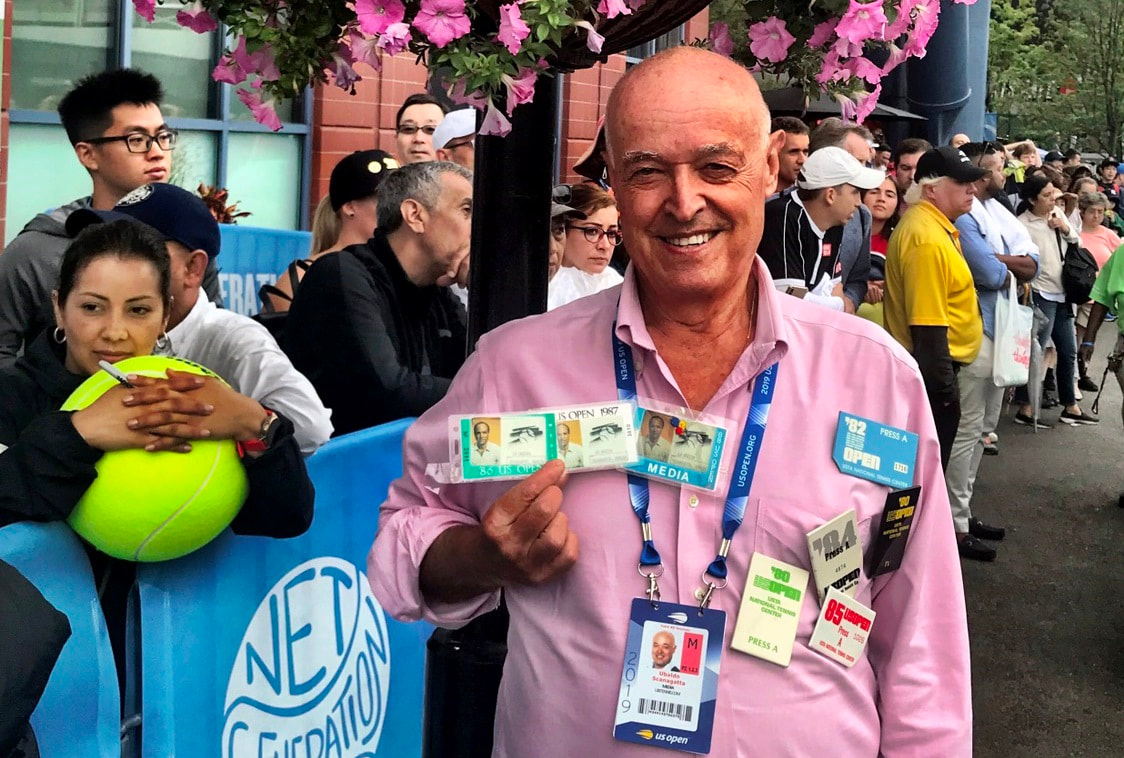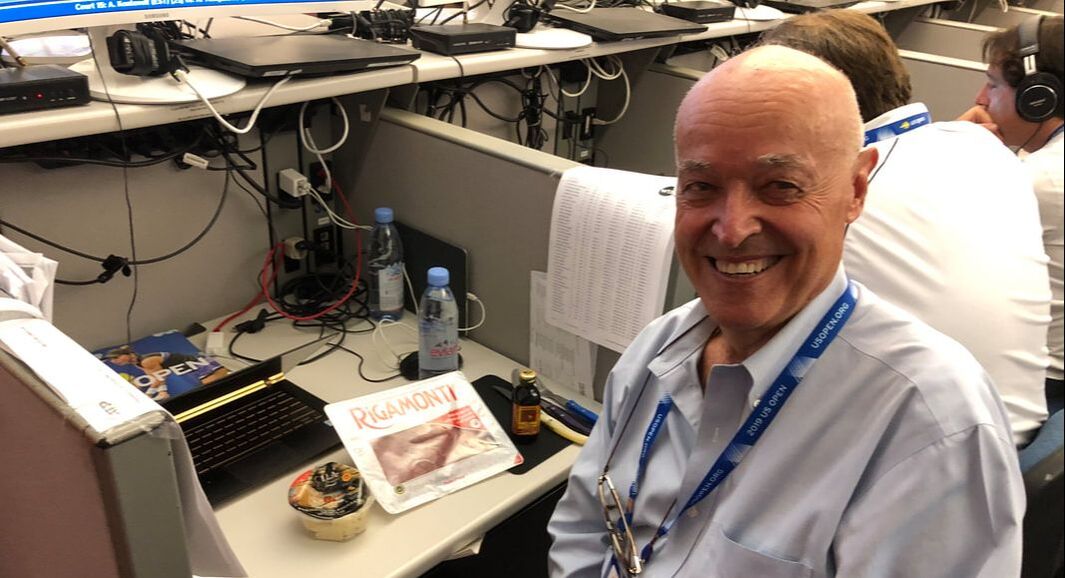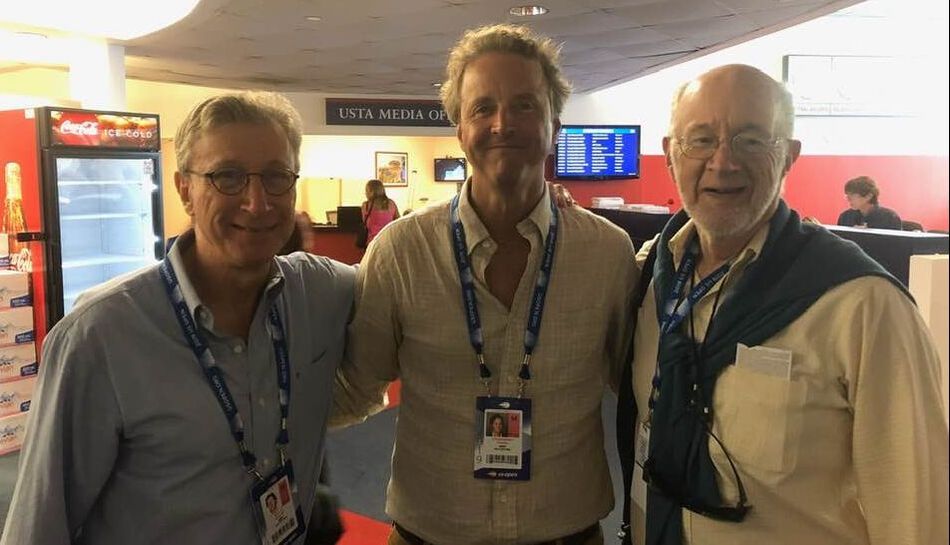|
Part of it is the tennis, of course. But I will admit, the high point of the U.S. Open these days, for me, is getting to see old friends and familiar faces, from decades of Opens and Wimbledons. Tennis is a traveling circus, quite unlike any other sport -- writers, commentators, experts, former players, coaches, business types, publicists and officials who pop up in sunny places from Melbourne to Monaco to Miami, kaleidoscopic yet permanent. (There was Virginia Wade, 1977 Wimbledon champion, with Queen Elizabeth II in attendance, looking as brisk as she did rushing the net, on her way, presumably to a BBC assignment.) I go to Flushing Meadows to see my friends, the ones who have survived the shrinking of the print-media corps. Some in this international rat pack seem to have been here forever –like Ubaldo Scanagatta from Florence, Italy, who files for three Italian papers and provides expertise on TV and radio on his site, Ubitennis.com. (In four languages.) Ubaldo – who turns 70 on Saturday -- knows how to live. On his annual fortnight in New York, he comes prepared with familiar food -- grated cheese (Colla Parmigiano Reggiano), olive oil (Esselunga Extra Virgin) and Rigamonti Bresaola, which is described online as “air-dried, salted beef that has been aged two or three months until it becomes hard and turns a dark red, almost purple color. It is made from top round, and is lean and tender, with a sweet, musty smell. It originated in Valtellina, a valley in the Alps of northern Italy's Lombardy region.” Even in these barbarian parts of the New World, it might perhaps be possible to find such Parmesan and Olive Oil and Bresaola, but Ubaldo takes no chances. He deigns eating with plastic, and therefore carries a real fork and a real knife in his kit, and when Italian players are not keeping him busy il mangia bene. One of the highlights of my journalistic career was before the Monday final in 2009, when Ubaldo invited a few American amici sportivi to the dining room, where he broke out the Parmesan, the Extra Virgin and the Bresaola. On Thursday I spotted Ubaldo in the Italian corner of the media writing room and I thought of other compatrioti famosi – Rino Tommasi, who analyzed the daily matchups on the Open programs for many decades, and Gianni Clerici, the squire of Lake Como, former amateur player (including Wimbledon, 1953), novelist, expert, with a waspish humor on and off the air. Clerici bestowed Italian heritage on Bud Collins, re-naming him “Collini.” But alas, Gianni does not come around anymore at 89, and neither does Rino at 85, and Bud passed in 2016. (The Media Center is named for him.) Many of my American friends are still typing and talking. A few days ago, I sat with tennis high priests Steve Flink and Joel Drucker during a match in Ashe Stadium, and also caught up with Johnette Howard, John Jeansonne, Wayne Coffey, Jeff Williams, Helene Elliott, Bob Greene, Anne Liguori, Chuck Culpepper, Andre Christopher and my tennis pal Cindy Shmerler. Three more were hanging together in the media center: NYT international reporter Chris Clarey, retired NYT columnist (but still active) Harvey Araton and Adam Zagoria, New York sports expert who writes for the NYT on occasion. Nice guy that he is, Adam took a photo of the three of us. For all the camaraderie, there is an air of nostalgia to the Bud Collins Media Center. A decade ago, the place bustled from morning to post-midnight with dozens and dozens of tennis writers from major cities – Boston, Miami, Denver, Orlando, Dallas, and on and on. There was a clatter of writers who were competitors but also friends – Robin Finn of the NYT provided a stash of Twizzlers (and really nasty nicknames for tennis stars.) Alas, falling circulation and earlier deadlines and changing Web priorities have cut back on the banter and the community.
The tennis endures. On Thursday, I watched in the lower press area of Arthur Ashe Stadium, as sixth-seeded Alexander Zverev of Germany matched his power and height against the mixture of power and drop shots of Frances Tiafoe, an American born in Sierra Leone. On a sleepy, sunny, pre-holiday afternoon, the predominantly American crowd urged Tiafoe as he befuddled Zverev in the second and fourth sets, but ultimately Zverev prevailed, 6-3, in the fifth. The fans surged out into the midway in search of refreshment or more tennis on the back courts. I went back to the Media Center to schmooze. 8/30/2019 05:27:57 pm
Great story about old friendships and food. If you add health and family, you have all the essential ingredients to enjoy life.
bruce
8/31/2019 08:43:29 pm
alan, 8/30/2019 09:02:30 pm
To include my name among the greats of ink-stained wretchedness is indeed and honor. And, yes, the Open is a great event.
Altenir Silva
8/31/2019 07:51:16 am
Dear George,
Roy Edelsack
9/1/2019 02:48:50 pm
I've been on the grounds every day this year, ignoring my Ashe seats to watch from the better vantage points available on all of the other courts. I met a delightful Englishman with a Commander Whitehead mustache and beard born within a mile of Wimbledon who has never been to The Championships but has been to Roland Garros and Melbourne. I met a group of fanatical Canadians with their "We the North" banner left over from the Raptors' championship parade rooting hard for Andreescu in her big win over Wozniacki. I met a delightful young woman usher and single mother working double shifts and somehow keeping her composure in the face of some challenging fan behavior.
George Vecsey
9/1/2019 04:10:34 pm
What great comments.
WAYNE COFFEY
9/3/2019 10:34:16 am
Thanks for this beautiful post, George. It was great to see you. When I grow up, I aspire to write as elegantly as George Vecsey.
Ed Martin
9/3/2019 04:15:52 pm
GV, another of your lovely stories. Being an old-timer, I recall Allison Danzig as The NYT tennis reporter. Ring a bell?
bruce
9/3/2019 04:29:22 pm
ed,
Ed
9/3/2019 10:07:13 pm
BRUCE, when he fell in the Mel Brooks film, “he was a dead ringer.”
George Vecsey
9/4/2019 05:56:28 pm
Ed: Yes, I met him during my Newsday days, and after I became NYT columnist in 82, there was a dispute about officiating at the Open and I called him at home (Roslyn) to ask if he ever remembered something similar. He could not have been more generous with time and memory.
bruce
9/3/2019 10:15:47 pm
ed, Comments are closed.
|
Categories
All
|












